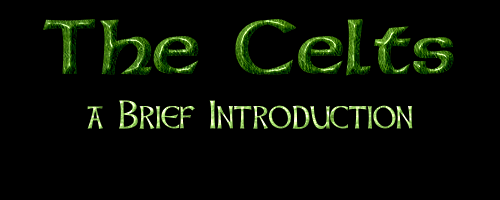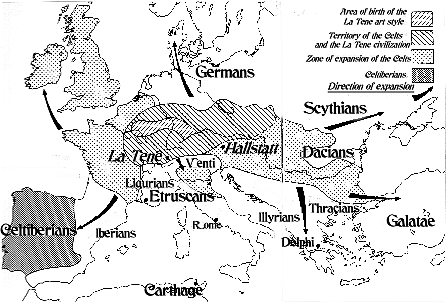|
|
|

This section will introduce you to the Celtic peoples and their lifestyle, it is very basic in nature and I recommend taking a look at the Suggested Reading area of Glamoury. There you can find a list of both fiction and non fiction Celtic literary selections, thus giving a more indepth look at the Celts.

Who were the Celts?
The Celts were the fist European people to emerge from the Alps into recorded history. They were set apart from other European peoples of the time because of the language that they spoke; which would later be referred to as Celtic. There were two distinct periods of Celtic culture, one being the Hallstatt dating from 1200 b.c. to 475 b.c. Hallstatt Celts were identified by their geometric art style and expert craftsmanship of Iron and other metals. As the Hallstatt era declined, the emergence of a new cultural style known as the La Tene period was beginning to flourish. Changes included new decorative art styles, transportation innovations, agricultural advancement, and economic improvement. The La Tene Celts were divided into tribes where they would be ruled by kings and over-kings. Such tribes would be as small as 20,000 to as large as 250,000 . In addition, the La Tene era achieved the most progress in regards to territorial expansion. Such included movement across the Alps into the Po valley, thus pushing back the Etruscans and later settling in the eastern seaboard of Italy. By this point the Celts inhabited Ireland, Britain, Belgium, France, and other Balkan countries. This, however, would not soon last; for the Roman and Greek powers were rising in strength and expanding their empires.
Where the Celts a Nation?
No, the Celts were not considered to be a true nation, but rather that of a culture that bonded a vast group of people together. Since there was no ruling continuity, or High King, the Celts could not be considered an empire, nor could they be classed as a nation.
What did the Celts Accomplish?
The Celtic people were responsible for developing the first recognized and genuine art style in central Europe. In addition, the Celtic knight brought forth the Age of Chivalry and its notions. Not to mention the wonderful inventions that the Celts contributed to such as chain armor, horse shoes, and the spooked wheel. Celtic farmers pioneered the usage of fertilizer and crop rotation.
Who were the Druids?
The Druids were the priests of the Celtic religion and accomplished natural scientists, with a vast knowledge of physics and astronomy. In summery they were teachers, healers, judges, poets, priests, as well as augers.
What did the Celts look like?
Good question. Because of the vast European territory that the Celtic people inhabited, their appearance ranged from a very fair Saxon like complexion, to a much darker Mediterranean look. They were described by various Roman and Greek scribes as being tall and elegant in body frame, with a very commanding presence and a fresh faced look. Celtic men kept their faces shaved with long dropping mustaches, and Celtic women braided their hair, pinning it up with combs and other ornaments. The Celts enjoyed jewelry and flashy clothing, with much adornment. The Roman Diodorus Siculus wrote of the appearance of Celtic children:
“Their children are born, for the most part, with gray hair,
but as they advance in age they are assimilated to the hair color of their parents.”
How did the Celts live?
The Celts were a farming culture, which was essentially nomadic in nature. They built two kinds of structures, the first being a domestic dwelling, or farmhouse; the other being the oppida or town. Their houses were described as being “…large and circular, built of planks and wickerwork, the roof being a dome of heavy thatch.” Where wood was sparse, as in some parts of Scotland, Celtic structures were made of stone with chambers, galleries, and stairs.
What did the Celts eat?
Traditional food for the Celts included: boiled pork, roast beef, bread, game and fish; along with cheese, curds, milk and butter. This, in turn, was followed with tankards of mead, beer and imported wines for the wealthy.
Who were those Celtic women?
The Celts valued their women just as much as their men, a far cry from the male dominated Roman society. It was recorded that Celtic women were found to be possessing of several husbands; this was supported by a documented conversation between a Celtic wife and a Roman matron:
“We fulfill the demands of nature in a much better way than do you Roman women,”
the Celtic lady then retorted, “for we consort openly with the best men,
whereas you let yourselves be debauched in secret by the vilest.”
This truly speaks volumes for the Celtic women and their great esteem and confidence. Diodorus Siculus again comments that “the women of the Celts, are nearly as tall as the men and they rival them also in courage.” In addition to these aforementioned things, Celtic women could rule and inherit property, unlike the women of many other contemporary cultures of the time. Examples of this include Queen Boudicca warrior queen of the Iceni and Queen Cartimandua of the Brigantes.